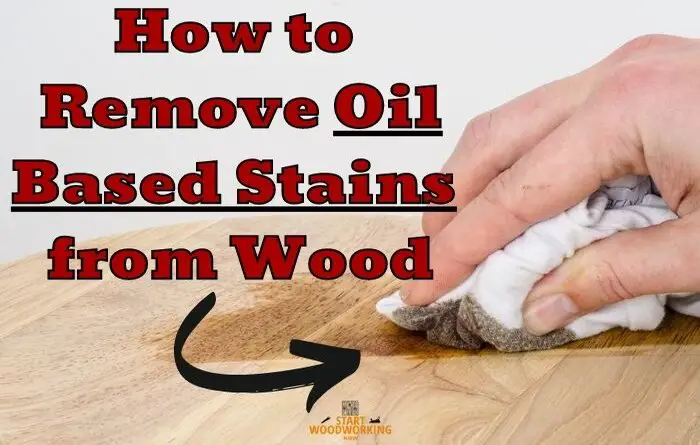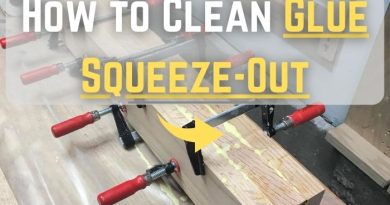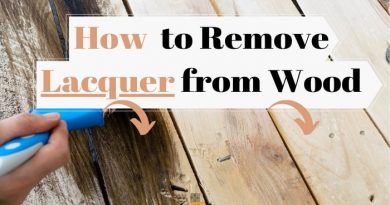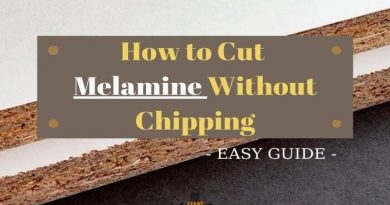How to Remove Oil Based Stain from Wood [Fast & Easy]
Nothing like an oil stain to mark a piece of furniture or parquet, especially if it is not properly protected by a suitable finish. Oil and wood can however go hand in hand! Here are some tips how to remove oil based stain from wood and choosing the right protection.
| Methods to remove oil from wood | Instructions |
|---|---|
| 1. 90 ° alcohol | Pass a cloth impregnated with 90 ° alcohol over the bowl to degrease it. Then rub the wood surface with fine steel wool, then vacuum |
| 2. Ammonia | Pass a cloth rolled into a ball soaked in a solution composed by half of ammonia and water |
| 3. Soda crystals | Degrease the wood with a solution of hot water and soda crystals (one cup of soda crystals for one liter of water). Rinse with clean water. Finish, if necessary, with a light sanding. |
| 4. Sanding | Sanding with 40 or 60 grit can work if the wood is not over oiled. |
| 5. Product for cleaning the oven | Because they contain soda, oven cleaners can be effective too. But be careful, on small surfaces, by using it in a very ventilated room, by protecting your shoes and by putting on household gloves. |
| 6. Baking powder | First put hot water on the oil stain and wait a few minutes. Then mix the baking soda with some water and spread the paste on the oil stain. After about a minute, remove the paste with a damp cloth and then apply wood care products. |
Do not breathe vapors given off by ammonia!
Ammonia should only be used in a well ventilated, well ventilated room, with hands protected by household gloves.
How to Remove Oil Based Stain from Wood
Step 1: Wipe the oil-based stain
The first step is to wipe the oil based stain as quickly as possible with a microfiber cloth (or if you don’t have one, with the first cloth you grab) before the oil has time to penetrate more in the wood surface. Sometimes this step is enough, sometimes you have to go further.
Acting as quickly as possible to remove the oil stain from the wood is particularly important if the affected surface is raw wood. In other words, if it is not protected the raw wood, especially certain particularly porous species, will tend to quickly absorb any fatty substance or unwanted oil stain. A bit like a sponge actually.
This is why we will always recommend that you apply a finish to your wood to protect it. And if you really want that raw wood effect, it is still possible to reproduce this effect while protecting the wood! We tell you more later in this article.
Step 2: Remove the Oil Based Stain from Wood using Degreaser
The rag was not enough and there is a little stubborn oil stain left on your wood?
It’s time to switch to degreasing spray ! This product is specifically designed to remove grease and oil stains from wood.
Be careful, however, we recommend that you buy it for prevention: it is indeed much more effective when you apply it directly after the appearance of the stain to prevent the oil grease from attaching to the wood.
So you can always run out and buy some after your blunder, but you might as well have some on hand in advance.
In the case of fresh oil stains, you should first soak up the liquid with kitchen towels. Then mix cleaning water with washing-up liquid and wipe the grease stain with it.
The fat dissolving ingredients help to remove the oil based stains from the wooden table. In the case of untreated wood, it is advisable to carefully dry the stain with the hairdryer.
Dissolve the old layer of furniture oil as much as possible by using the water/soda solution. Wipe the wood well with the lint-free cloth.
Wait for the wood dry before moving on to the next step.
Step 3: Clean the wood with Neutral PH Soap
We then recommend that you clean the wood thoroughly with a good neutral pH soap.
Which soap to choose? Here, everything depends on the surface concerned.
If you want to clean the wood outdoors, such as a garden table or a wooden terrace, prefer outdoor soap : this is indeed designed to not only clean the exterior wood, but also to nourish it and keep insects away.
In case of parquet, staircase or interior furniture, we recommend the ready-to-use interior soap . You can also use our concentrated soap to dilute in water, if you need a stronger action.
Step 4: Sand the Wood if Required
Sanding is the best solution to completely remove the oil layer from the wood. Start with a very low grit (80) and finish with a higher (120) fine grit. If the discs still fill up too quickly, it may be that the old layer of furniture oil has not yet cured properly.
We then advise you to let the furniture oil dry for another two weeks to make sanding easier. Then sand completely bare to properly remove the oil from the wood. After sanding, clean the wood surface with a damp cloth. Wait with the next step until the wood is dry.
Sand lightly and retry the above steps to clean the wood. Sanding should nevertheless be used as a last resort and must remain light so as not to damage your beautiful wood furniture or parquet.
Step 5: Protect the wood
The wood will no longer be protected after the previous steps, which will make it permeable to stains leaving you with the following choices:
– treat the wood again with oil
– apply a coat of varnish
– protect furniture, parquet with an appropriate treatment
This colorless wax oil protects the wood and the color against dirt and moisture. Which one you choose depends on the desired effect. Apply the wax oil with a firm brush or roller. Rub off the excess oil.
We recommend applying at least two layers of wax to protect the wood as optimally as possible. The drying time depends on the ventilation and ambient temperature.
TRY THESE TIPS WHEN REMOVING OIL FROM WOOD
- Always clean the oil or grease on the spot. Do not let the stain dry, or it will cost more to remove.
- Cornmeal is a good oil absorbent. We recommend using it to lift the stain.
- For wood, it is better to use a good amount of foam so as not to damage the furniture and remove the oil.
- If you use chemical products, do a previous test in an area of the wooden furniture that is not visible, to avoid major disasters in case it is not suitable for your furniture.
- Try to bind large amounts of oil that has leaked out immediately, for example by sprinkling it with sawdust, cat litter or flour.
- This way you will keep the stain as small as possible.
How to Remove Oil Based Stains without Damaging the Wood Surface
To remove oil based stains from wood without affecting its surface, we recommend doing the following:
- Put some detergent in a bowl of hot water and stir until a good amount of foam is generated.
- Moisten a cloth in the foam and wrung it out to remove the excess water.
- Rub the oil stain gently.
- Rinse the wood surface with a damp cloth.
- After removing all the foam, dry it as soon as possible with the help of a hair dryer, to remove any sign of moisture.
| Type of Oil Based Stain | Ways to remove it from wood |
|---|---|
| 1. Cooking oil | 1.Detergent and hot water mix together and applied to the wood surface. 2. Cover the oil stain with sand, wait until the oil is absorbed then sweep it off with a broom. |
| 2. Engine Oil | 1.Baking soda or cornstarch with hot water. 2.Mineral spirits: Scrub motor oil stains with mineral-soaked spirits or naphtha cloth, rag or mop. |
| 3. Mayonnaise | Warm soapy water and a cloth or paper towels. |
| 4. Gasoline | 1.Use talcum powder , which manages to pull the gasoline fuel and then has to be brushed off dry. 2.Using trichlorethylene , the gasoline stains on the wood should disappear. |
| 5. Butter | Blotting paper with baking soda or vinegar. Then run a heated iron over the surfaces |
| 6. Linseed-oil | 1. Sand the wood surface using sandpaper. 2.Turpentine and a rag. |
How to Remove Fresh Oil Based Stain from Wood
Wood is the star material of almost all furniture. Although it is not very difficult to clean, you must take into account some aspects if you do not want to damage it, especially if we are talking about oil based stains , which are somewhat difficult to remove.
The best way to remove a fresh stain of oil is to cover it with sand, wait until the oil is absorbed, then sweep it off with a broom. Another effective method would be caustic soda, which chemically reacts with the oil. But, despite all efforts, the stain will remain partially in the wood.
The process of removing a fresh oil based stain from wood you must carry out delicately, taking into account the following steps:
- Use a good detergent to clean the wood.
- Mix it with hot water. You will want to get the solution to make a good amount of foam before pouring it on the oil based stain.
- Once the foam is obtained, soak a cloth or sponge with it.
- Remember to remove the excess water, we only want it to be wet.
- Rub the oil based stains carefully.
- Afterward, rinse the soapy area with a clean cloth or cloth slightly dampened with water.
- When you have removed all the foam and rinsed the area, dry it quickly, as the humidity can play a trick on the wood.
Another trick to remove fresh oil based stains from wooden furniture is to use a hair dryer.
Steps to do it:
- Heat the stained area with a hair dryer to remove the oil based stain.
- Next, apply a piece of absorbent kitchen paper to trap the oil on the furniture.
- Then pass a cotton ball soaked in hydrogen peroxide to finish cleaning the area.
You must be very careful when cleaning wooden furniture. Do not hesitate to look for suitable cleaning products to make sure you do not damage your furniture.
How to Remove a Dried Oil Based Stain from Wood
In such a situation, no sand will help. It is necessary to use only special products offered on the market by manufacturers of chemical products (mineral spirits). The chemical method of removing greasy oil stains from wood is the most effective.
Choose the one that is suitable for the wood from among the many special washes. An insider tip for removing particularly stubborn oil based stains is a mixture of mineral spirits and flour.
The main components in the solution are important, the action of which is aimed at splitting oil molecules in the pores of the wood.
1.Carefully study the instructions, use protective equipment when working with a chemical solution as mineral spirits.
2.Mix both to a pulpy mass apply the liquid solution to the oil stain carefully so that it does not spread over the entire surface. Use a special roller, brush or spray for this.
3.Wait a while, watching for the reaction. Foam should appear as a result of the decomposition of oil molecules.
4.The remains of the chemical reaction must be carefully collected with a dry cloth or brush, then the wood must be rinsed with warm water.
The effect of a special chemical agent on the oil stain will be a good solution to the problem of how to remove oil from the wood, and a clean wood surface.
How to Remove Oil Based Stains from Hardwood Floors
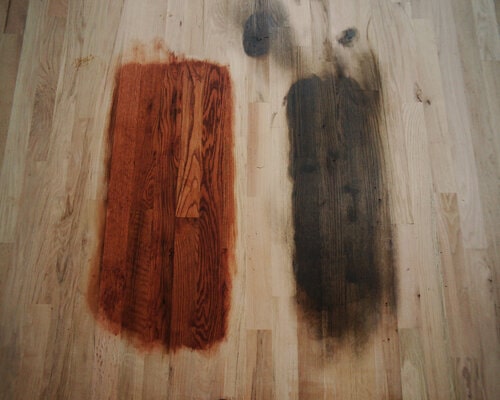
Hardwood floors, walls and furniture are sources of beauty for the home. To preserve them and maintain the finish for a long period of time, it is not enough to just wipe them with a cloth and dust them, but also to immediately remove accidental oil stains that may happen.
Oil based stains can be tricky to remove. Removing oil from hardwood floors requires an understanding of these two materials and the proper tools.
Step 1: Use paper towels, newspaper, or blotting paper to absorb the oil stain from the wood surface. These materials will absorb any moisture and oil remaining in the wood.
Blot the oil stain with a clean paper towel or blotter. Blotting paper is made to absorb moisture and will pick up excess oil from a fresh stain.
Step 2: Dampen a clean cloth with dry cleaning fluid and press it onto the stain and let it sit for five minutes. This method is even more effective at removing excess moisture and oil from the wood or fill a bucket with hot water and a mild dish soap. Form a layer of soap suds over the oil stain.
Step 3: Mix detergent and warm water in a bowl until foaming. Apply the foam to the stain and rub it with the clean cloth. After that, rinse with water and dry the area.
Step 4: Work the soap suds into the stain as much as you can. Some finished wood surfaces will not absorb soap. Then rinse with clean water.
Step 5: Wait for the surface to dry and check for any stains. It can be difficult to determine if the stain is gone when the wood is wet.
Step 6: Use turpentine and cleaning products that remove oil from wood for tougher stains, using a clean cloth and rubbing the substance with one of the aforementioned products. Gently rinse and dry the area completely.
If the stain remains, treat it with a stronger substance. Mineral spirits, also called Stoddard solvents, are chemical thinners and removers available at your local hardware store and can remove tough oil stains. Pour some onto a cloth and rub over the stain.
Here is a guide how to remove different kind of stains from wood in a simple way!
Remove Oil stains from Raw Wood Surfaces
Currently, not all furniture is made of wood. It is possible that the furniture in your home is made of multiple materials, from glass or marble, to acrylic or ceramic surfaces. Therefore, it is necessary that you also know how to remove oil stains on these types of raw (smooth) surfaces so that everything is clean and shiny.
The steps are simple:
- Wipe the surface where the stain is with a dry cloth or rag and wipe off any excess oil.
- Once the area is dry, wipe the surface of the furniture with a sponge or cloth soaked in warm water with a little soap.
- Rub gently to make sure the soap will wash away all the dirt.
- Lastly, rinse the stained area well and dry it with a dry cloth.
The smooth surfaces of the most modern furniture are much easier and faster to clean. In addition, their composition helps them to be slippery since the products that are used or that are poured on them do not penetrate the furniture or damage it.
The only thing you should keep in mind in this type of material is that you should not let the oil dry, since afterwards you will have to rub harder and it will take longer to lift the stain.
*Cornmeal is a good oil absorbent. We recommend using it to lift the stain.
*For wood, it is better to use a good amount of foam so as not to damage the furniture and remove the oil.
*If you use chemical products, make a previous test in an area of the furniture that is not visible, to avoid major disasters in case it is not suitable for your furniture.
Conclusion
If you have stained your wood with oil, you should take countermeasures as soon as possible because it will be absorbed into the surface very quickly. The later you treat the oil stain, the more complex it is to remove.
We have collected the best methods for you to learn how to remove oil based stain from wood. Follow any of these methods and see what suits you and your needs.
After the successful stain treatment, consider whether you don’t want to prevent such mishaps in the future and varnish or otherwise treat your wood so that it is resistant to stains.

